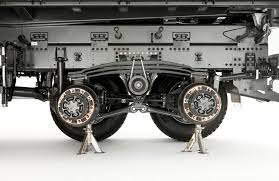
The device and principle of operation of the dependent suspension
Content
Dependent suspension differs from other types of suspension by the presence of a rigid beam connecting the right and left wheels, so that the movement of one wheel is transferred to the other. Dependent suspension is used where there is a need for simplicity of design and low-cost maintenance (low-cost cars), strength and reliability (trucks), constant ground clearance and long suspension travel (SUVs). Let's consider what advantages and disadvantages this type of suspension has.
Principle of operation
The dependent suspension is a single rigid axle that connects the right and left wheels. The operation of such a suspension has a certain pattern: if the left wheel falls into the pit (vertically down), then the right wheel rises up and vice versa. Usually, the beam is connected to the car body using two elastic elements (springs). This design is simple, yet it provides a secure connection. When one side of the car hits a bump, the entire car tilts. In the process of driving, jolts and shaking are strongly felt in the car, since such a suspension is based on a rigid beam.
Varieties of dependent suspensions
Dependent suspension is of two types: suspension with longitudinal springs and suspension with guide levers.
Suspension on longitudinal springs
The chassis consists of a rigid beam (bridge) that is suspended from two longitudinal springs. The spring is an elastic suspension element consisting of bonded metal sheets. The axle and springs are connected using special clamps. In this type of suspension, the spring also acts as a guiding device, that is, it provides a predetermined movement of the wheel relative to the body. Despite the fact that the dependent leaf spring suspension has been known for a long time, it has not lost its relevance and is successfully used to this day on modern cars.
Suspension with trailing arms
The dependent suspension of this type additionally consists of four diagonal or three to four longitudinal rods (levers) and one transverse rod, called “Panhard rod”. In this case, each lever is attached to the car body and to a rigid beam. These auxiliary elements are designed to prevent lateral and longitudinal movement of the axis. There is also a damping device (shock absorber) and elastic elements, the role of which in this type of dependent suspension is played by springs. Suspension with control arms is widely used in modern cars.
Balance suspension
We should also mention the balance suspension - a type of dependent suspension that has a longitudinal connection between the wheels. In it, the wheels on one side of the car are connected by longitudinal jet rods and a multi-leaf spring. The impact from road irregularities in the balancer suspension is reduced not only by elastic elements (springs), but also by swinging balancers. Redistribution of the load improves the smoothness of the vehicle.
Elements of spring dependent suspension
The main components of the leaf spring suspension are:
- Metal beam (bridge). This is the basis of the structure, it is a rigid metal axle that connects two wheels.
- Springs. Each spring is a set of elliptical metal sheets of different lengths. All sheets are connected to each other. The springs are connected to the axle of the dependent suspension using clamps. This component acts as a guiding and elastic element, as well as partly a damping device (shock absorber) due to inter-sheet friction. Depending on the number of sheets, the springs are called small and multi-sheet.
- Brackets. With the help of them, the springs are attached to the body. In this case, one of the brackets moves longitudinally (swinging shackle), and the other is fixed motionless.
Elements of a spring dependent suspension
The main components of a spring dependent suspension, in addition to a metal beam, are:
- elastic element (spring);
- damping element (shock absorber);
- jet rods (levers);
- anti-roll bar.
The most popular suspension of this type has five arms. Four of them are longitudinal, and only one is transverse. The guides are attached to the rigid beam on one side and to the vehicle frame on the other. These elements allow the suspension to absorb longitudinal, lateral and vertical forces.
The transverse link, which prevents the axle from displacing due to lateral forces, has a separate name - “Panhard rod”. Distinguish between continuous and adjustable Panhard rod. The second type of wishbone can also change the height of the axle relative to the vehicle body. Due to the design, the Panhard rod works differently when turning left and right. In this regard, the car may have certain handling problems.
Advantages and disadvantages of dependent suspension
The main advantages of the dependent suspension:
- simple construction;
- inexpensive service;
- good stability and strength;
- large moves (easy overcoming of obstacles);
- no change in track and ground clearance when driving.
A significant drawback is this: a rigid connection of the wheels, coupled with a large axle mass, negatively affects the handling, driving stability and smoothness of the vehicle.
The following requirements are now imposed on the suspension: ensuring a high level of passenger comfort while driving, good handling and active safety of the car. The dependent suspension does not always meet these requirements, and that is why it is considered obsolete. If we compare the dependent and independent suspension, then the latter has a more complex design. With an independent suspension, the wheels move independently of each other, which improves the car's handling and smoothness.
Application
Most often, the dependent suspension is installed on vehicles that require a strong and reliable chassis. The metal axle is almost always used as the rear suspension, and the front suspension beam is practically not used anymore. Off-road vehicles (Mercedes Benz G-Class, Land Rover Defender, Jeep Wrangler and others), commercial vehicles, as well as light-duty trucks have a dependent chassis. Often a rigid beam is present as the rear suspension of budget cars.
